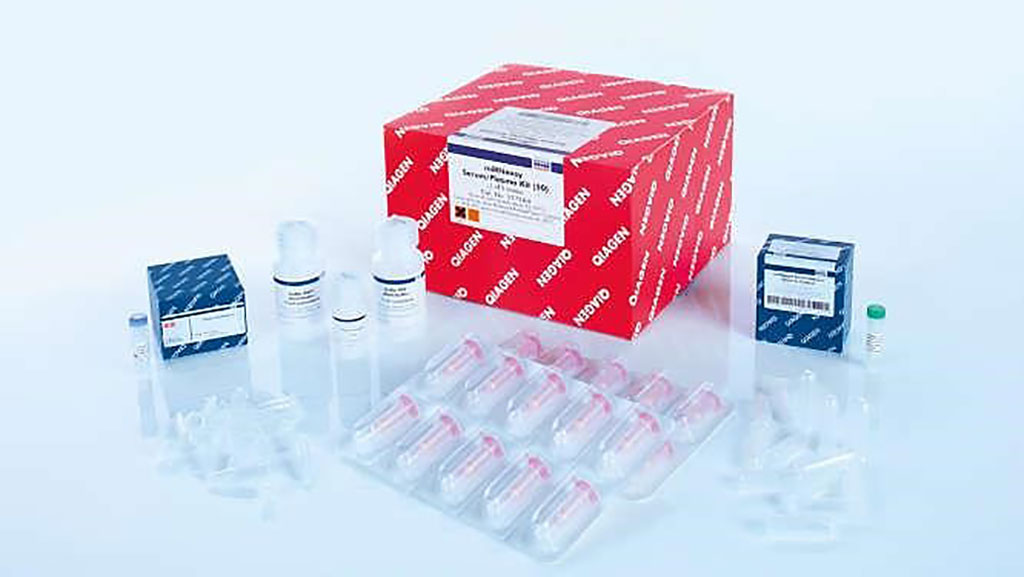Serum MicroRNA Panel Predict P-Tau/Aβ42 in CSF in Alzheimer's Disease
By LabMedica International staff writers
Posted on 29 Nov 2021
Amyloid β (Aβ) and tau pathologies are classic characteristic features of Alzheimer’s disease (AD), and they are widely used as diagnostic biomarkers. AD pathology is characterized by the accumulation of amyloid-β (Aβ) plaques and tau neurofibrillary tangles in the brain.Posted on 29 Nov 2021
Aβ and tau in samples of CSF obtained from patients has been shown to diagnose AD with excellent accuracy. Multiple studies have suggested that the combined measurements of phosphorylated-tau (P-tau) and Aβ42 in the CSF can inform a more accurate diagnosis than either test alone.

Image: The miRNeasy Serum/Plasma Kit: For purification of cell-free total RNA, including miRNA, from human plasma and serum (Photo courtesy of Qiagen)
A team of Neurologists at the Capital Medical University (Beijing, China) extracted RNA samples from the participant's blood. P-tau/Aβ42 of CSF was examined for diagnostic purposes. A pilot study (controls, 21; AD, 23), followed by second (controls, 216; AD, 190) and third groups (controls, 153; AD, 151), was used to establish and verify a predictive model of P-tau/Aβ42 in CSF. The test was then applied to a fourth group of patients with different dementias: AD,155; amnestic mild cognitive impairment (aMCI), 55; vascular dementia (VaD), 51; Parkinson disease dementia (PDD), 53; behavioral variant frontotemporal dementia (bvFTD), 53; dementia with Lewy body (DLB), 52) and 139 controls, to assess its diagnostic capacity
The levels of Aβ42, total-tau (T-tau), and P-tau (tau phosphorylated at Thr 181) in the CSF were then measured using an INNOTEST enzyme-linked immunosorbent assay (ELISA) kits (Fujirebio Diagnostics, Tokyo; Japan). Total RNA was isolated using the miRNeasy Serum Kit (Qiagen, Germantown, MD,USA). For the preparation of the sequencing library, the team used 1 μg of total RNA quantified with Nano Drop 8000 (Thermo Fisher Scientific, Waltham, MA, USA) and Agilent 2100 Bioanalyzer (Agilent Technologies, Santa Clara, CA, USA).
The investigators reported that in the pilot study, 29 upregulated and 31 downregulated miRNAs in the AD group were found. In Dataset 2, these miRNAs were then included as independent variables in the linear regression model. A seven-microRNA panel (miR-139-3p, miR-143-3p, miR-146a-5p, miR-485-5p, miR-10a-5P, miR-26b-5p, and miR-451a-5p) accurately predicted values of P-tau/Aβ42 of CSF. In Datasets 3 and 4, by applying the predicted P-tau/Aβ42, the predictive model successfully differentiates AD from controls and VaD, PDD, bvFTD, and DLB.
The authors concluded that the results of their study indicate that a panel of seven miRNAs are potential blood biomarkers for AD. Specifically, the association between the levels of seven miRNAs and the P-tau/Aβ42 ratio in the CSF of AD patients confirms that miRNA biomarkers may reflect pathological changes in the brain and, therefore, can inform the identification of patients with AD. The study was published on November 15, 2021 in the journal BMC Medicine.
Related Links:
Capital Medical University
Fujirebio Diagnostics
Qiagen
Thermo Fisher Scientific
Agilent Technologies














